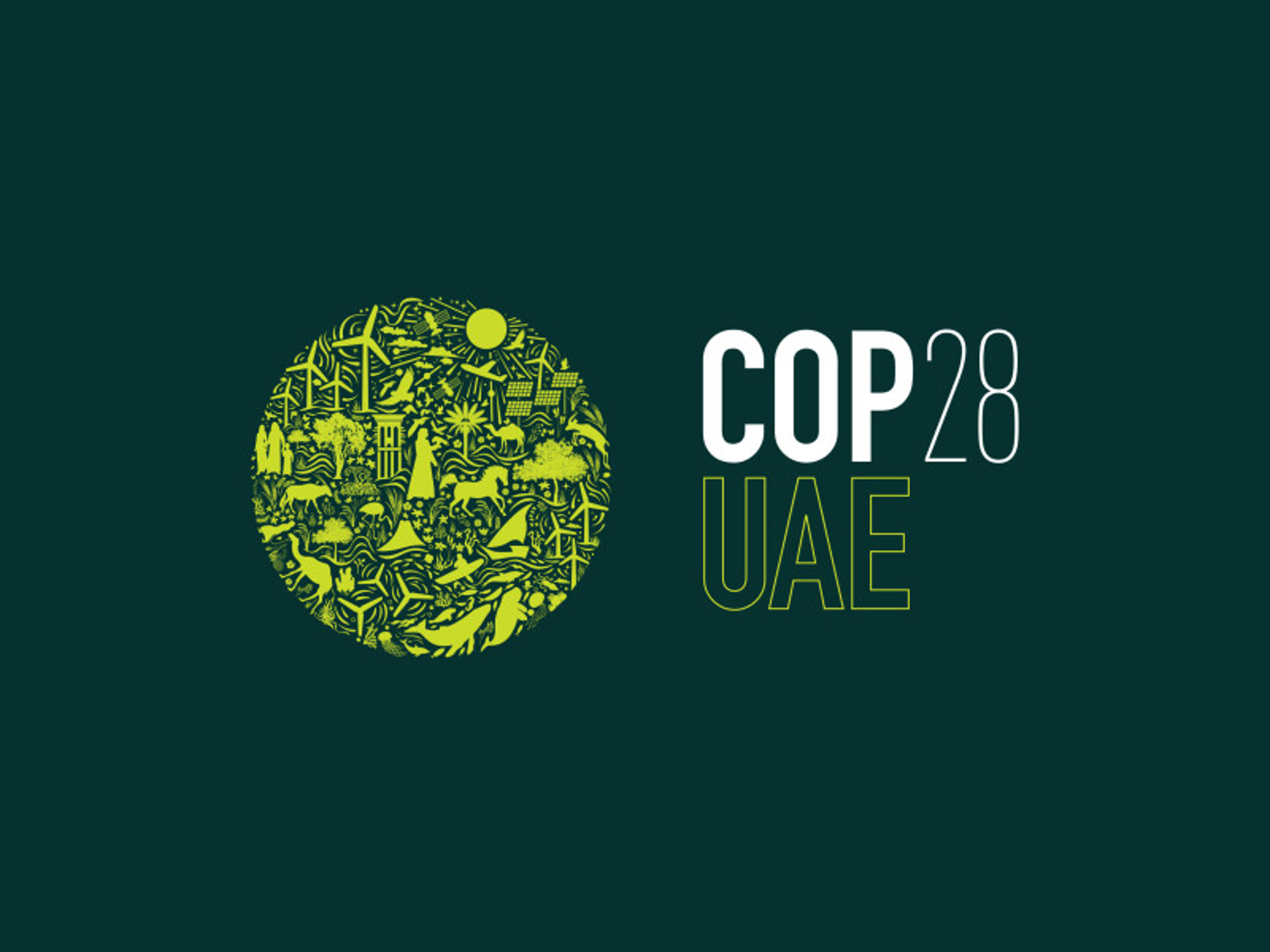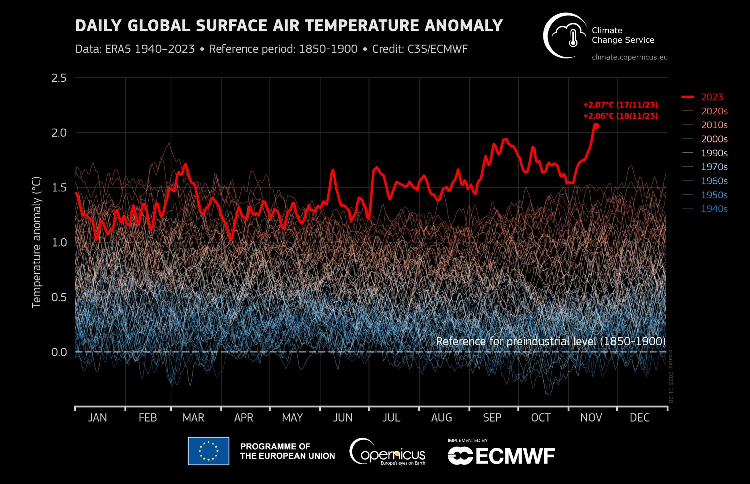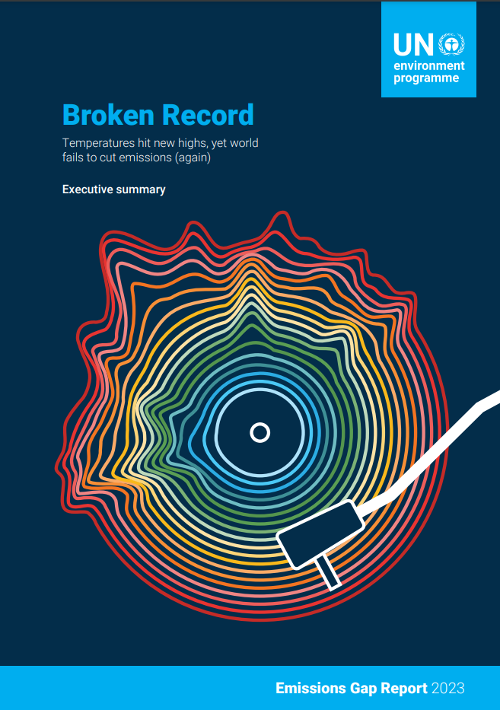The Last Chance for 1.5ºC?
COP 28 Overview
As we near the end of what is probably the hottest year on record, a year of disasters inflamed by climate change, it seems fitting that we close out the year with another UN climate conference. This will be the 28th official meeting of the Conference of the Parties to the United Nations Framework Committee on Climate Change, aka COP 28. The COP is the top decision-making body of the UNFCCC. Its annual meetings host leaders from all over the world who meet to discuss and agree international climate policy. In 2015, COP 21 gave rise to the Paris Agreement treaty to limit global temperatures to below 2°C, and preferably below 1.5°C.
Major international issues are up for negotiation at COP 28, which is taking place in Dubai, United Arab Emirates (UAE) from November 30 through December 12th, 2023. Given the contentious role of fossil fuels in climate change, locating COP 28 in the UAE, a major petrostate, should be interesting. As will the efforts of the President of COP 28, Dr. Sultan Ahmed Al Jaber, whose day job is CEO of ADNOC (the Abu Dhabi National Oil Company.)

Image Credit: COP28
A key agenda item is the first global stock-taking of climate action on Paris Agreement goals, a two year effort that will wrap up at COP 28. Its results are intended to inform the next round of climate action plans. (Spoiler alert: we’re way behind.)
The results of COP 28 will tell the tale, but the high-level daily agenda presses all the right buttons:
- World Climate Action Summit (2 days)
- Health/Relief, Recovery and Peace
- Finance/Trade/Gender Equality/Accountability
- Energy, Industry and Just Transition
- Mulitlevel Action, Urbanization and Built Environment/Transport
- Youth, Children, Education and Skills
- Nature, Land Use and Oceans
- Food, Agriculture and Water
- Final Negotiations (2 days)
This Just In:
On November 27, three days before the conference convenes, and after I wrote the above COP 28 Overview, the BBC dropped a bombshell article titled “COP28: UAE planned to use climate talks to make oil deals.” The title says it all, but the article goes into considerable detail. According to leaked documents obtained by the BBC and a partner organization, the UAE has plans to discuss fossil fuel deals with 15 countries ahead of the conference. The leaked briefing documents were prepared for Dr. Al Jabar. When contacted by the BBC, “The UAE team did not deny using COP28 meetings for business talks, and said “private meetings are private”.”
Where We Are
On November 17th, global surface air temperature reached 2.07°C above the pre-industrial average, the first day in which the global temperature exceeded 2°C above preindustrial levels. While this is only a single day’s observation, not the global multi-year average that would constitute 2°C of global warming, its occurrence just before the opening of COP 28 is deeply symbolic. This is one more example of record-breaking trends that are more alarming than many climate scientists expected.
Credit: C3S/ECMWF
In the lead-up to COP 28, the UN Environment Programme (UNEP) issued its annual Emissions Gap Report (EGR), a scientific analysis of our progress in meeting the goals of the 2015 Paris Agreement—limiting global warming well below 2°C and making best efforts to keep it to 1.5°C. The EGR science team assesses the gap between projected greenhouse gas emissions based on national commitments, and where emissions need to be to meet Paris Agreement goals.
The 2023 EGR, aptly titled “Broken Record – Temperatures hit new highs, yet world fails to cut emissions (again)” doesn’t pull any punches. (The EGR cover design is brilliant, too.)
The EGR finds that current national commitments under the Paris Agreement put the world on track for a 2.5-2.9°C temperature rise above preindustrial levels this century, with no hope of reaching the 1.5ºC goal.
Clearly, there is an urgent need for increased climate action across the board.
There has been progress since the Paris Agreement was signed in 2015, just not enough of it. Greenhouse gas emissions in 2030, based on policies in place when the agreement was adopted, were projected to be 16% higher. In 2023, the projected increase from 2015 levels is down to 3%—still an increase though. However, predicted 2030 greenhouse gas emission must fall by 28% for the Paris Agreement 2°C pathway or 42% for the 1.5°C pathway.
As things stand, fully implementing Nationally Determined Contributions (NDCs) already made under the Paris Agreement would put the world on track for limiting temperature rise to 2.9°C above preindustrial levels this century. Fully implementing “conditional” NDCs would lower this to 2.5°C. (Conditional NDCs were submitted by nations incapable of meeting their NDC goal without financial and/or technical assistance.)
Inger Andersen, Executive Director of UNEP, puts it bluntly: “Given the intense climate impacts we are already seeing, neither outcome [2.9 or 2.5] is desirable.” CAC articles covered many of those “intense climate impacts.” Some recent examples are here, here, and here.
Bottom line: COP 28 needs to produce new, more ambitious NDCs, particularly by the G20 countries, if we are to have a chance of meeting either of the Paris Agreement goals.
An Example: Climate Change Impacts in the Southeastern US
Of necessity, the EGR looks at climate change with a global perspective, but climate change impacts vary widely from region to region. As one example, the US is warming even faster than the global average.
The recently published “Fifth National Climate Assessment” (NCA5) by the US Global Change Research Program gives us the opportunity to look at climate change in the US from national and regional perspectives. At the national level, NCA5 summarizes the US climate predicament with this statement: “The observed warming and other climatic changes are triggering wide-ranging impacts in every region of our country and throughout our economy.” At a more detailed level, NCA5 looks at climate change as it’s experienced by each of ten regions.
The Southeast region is one of the ten regions covered in NCA5. It is also home to CAC headquarters in Sarasota, Florida, and to many CAC supporters. In the Southeast, one example of the wide-ranging impacts of climate change is the growing risk of inland and coastal flooding, illustrated in the following map.

Credit: NCA5
Further narrowing it down to the effect of sea level rise on coastal flooding, according to NCA5 relative sea level throughout the Southeast rose by roughly 6 inches from 1970 to 2020. By 2050, the average Southeast sea level is projected to be 16 to 23 inches higher, depending on how successful we are at limiting climate warming. Estimates for the Southeastern US are actually higher than the projected global average sea level rise because of regional variations in land motion, excessive groundwater pumping, and the effects of sea level changes caused by changes in ocean currents, notably the Gulf Stream. The number of high tide flooding events in the Southeast may increase by a factor of 5 to 10 by 2050 due to sea level rise. However, many communities will experience comparable increases in these events before 2050 due to changes in tides that amplify sea level rise. Saltwater intrusion resulting from rising sea levels will further degrade the health of coastal forests and estuaries and increase soil salinity.
There’s more to climate change than warming temperatures!
What Needs to Happen at COP 28
The chart below depicts the global growth in greenhouse gas (GHG) emissions from 1990 through 2022. Clearly, efforts to date to reduce emissions have not been able to reverse the trend of ever-increasing emissions. It is also clear that the majority of GHG emissions arise from burning fossil fuels. Despite ongoing efforts to reduce GHG emissions, total emissions will be only 2% lower by 2030.
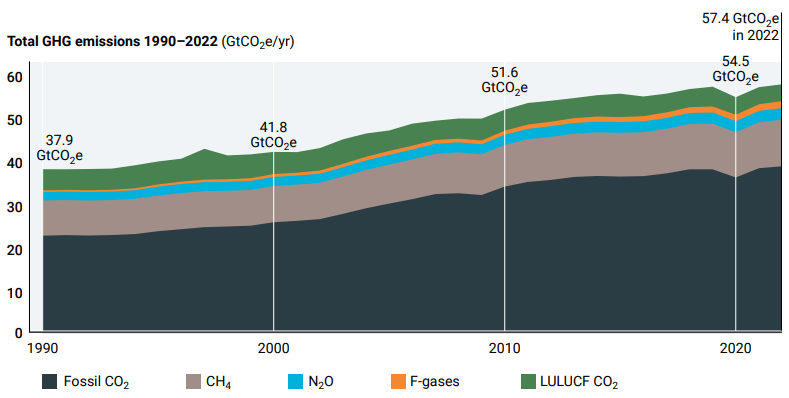
Total Emissions, 1990-2022
CH4 is methane, N2O is nitrous oxide, F-gases are fluorinated gases used in industry. LULUCF refers to Land Use, Land Use Change, and Forestry. Credit: EGR 2023
The next chart shows projected GHG emissions under a variety of scenarios. The Paris Agreement goals are represented by the dark blue line—the decline in GHG emissions necessary to stabilize global temperatures at 2ºC above preindustrial levels, and by the grey line—the GHG emissions path to limit climate warming to 1.5ºC above preindustrial levels. The 1.5ºC and 2ºC paths are largely determined by the year in which the goal of net zero emissions must be reached—2050 and 2065-2070, respectively.
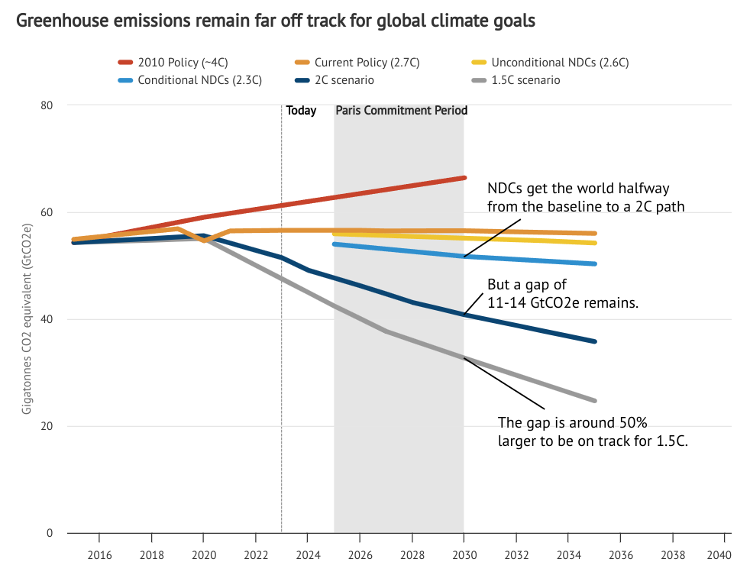
Credit: Carbon Brief source: EGR2023
The grey zone from 2025 to 2030 is the period for which direction will be provided by COP 28 in 2023 and targets (reflected in updated NDCs) negotiated in 2024 and 2025. The UNFCCC calls this process the “Global Stocktake.” Built into the Paris Agreement, the Stocktake is a periodic assessment of how nations are performing against the goals to which they agreed. COP 28 marks the conclusion of the first Global Stocktake. An excellent explainer of the Global Stocktake process and its application can be found here. Expect to hear more about it during and after COP 28.
Even though the 1.5ºC goal looks increasingly difficult to reach, it is still (just barely) technically feasible. For that reason, we should make our best efforts to “keep 1.5 alive,” as the saying goes. If we consider the climate chaos we have endured this year, at a global temperature roughly 1.2ºC above preindustrial levels, a future at 2ºC isn’t very attractive. Far better to strive for 1.5ºC, and invest in Carbon Dioxide Removal (CDR) to eliminate any overshoot of our emissions goal.
All of this has gone into Dr. Al Jabar’s creation of the following President’s goals for COP 28. Goals specifically intended to keep 1.5 alive.
- Tripling renewable energy capacity and doubling the rate of energy efficiency improvements across sectors by 2030, including ramping up electrification and enhanced cooling approaches, to enable phase-down of fossil fuels.
- More than halving oil and gas industry scope 1 and 2 emissions, including reaching near-zero methane emissions by 2030.
- Transforming heavy-emitting sectors, including scaling up use of low-carbon hydrogen, carbon capture and storage, and carbon dioxide removal, aligned with science.
- Substantially shifting toward fossil-free forms of transport, including through vehicle electrification and modal shifts.
- Taking action to accelerate efforts towards the phase-down of unabated coal power and phase-out of inefficient fossil fuel subsidies, addressing coal-related methane emissions and deploying clean baseload capacity.
- Companies and countries set ambitious goals, take action, and remain accountable through disclosures, in line with best practices and global standards.
There is some contentious wording in there, notably the use of “phase-down” instead of “phase-out” when it comes to fossil fuels. Not unexpected from the CEO of an oil and gas giant.
Wordsmithing aside, the headline goal is tripling renewable energy capacity and doubling the rate of energy efficiency improvements by 2030.
Are the COP 28 Goals Achievable?
The basis for the goal of tripling renewable energy capacity and doubling the rate of energy efficiency improvement is the record growth of key clean energy technologies. The International Energy Agency (IEA) describes how that enables a feasible pathway to 1.5ºC in “Net Zero Roadmap: A Global Pathway to Keep the 1.5ºC Goal in Reach” released in September 2023.
The foundation of the IEA plan is tripling renewable energy capacity and doubling the rate of energy efficiency improvement. In fact, the IEA states that tripling of global renewable capacity is the “single largest driver” of emissions reductions to 2030 in its roadmap. The following figure shows how this works.
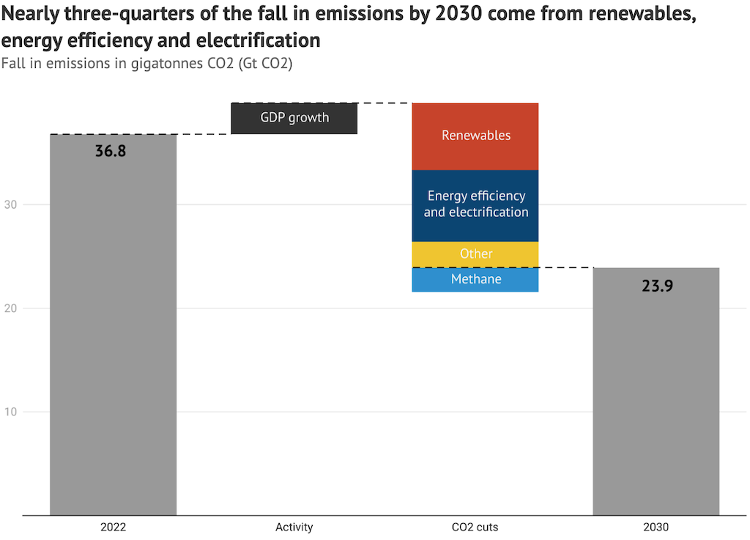
Projected change in global energy-related CO2 emissions between 2022 and 2030, under the IEA’s 1.5ºC Roadmap Credit: Carbon Brief
The figure illustrates global emissions from energy production, which is the source of roughly two-thirds of total global GHG emissions. Allowing for growth in energy demand, reflected by GDP growth by 2030, then the combination of energy generated by renewables instead of fossil fuels, the reduction in energy demand through increased efficiency, the increased electrification of activities currently based on fossil fuels (transportation, building heating/cooling, etc.) account for roughly three-quarters of the total emissions reduction by 2030.
Much of the potential reduction in Methane emissions is a by-product of tripling the use of renewable energy, which will displace roughly half of the coal currently used for power generation. IEA estimates a 75% reduction of global Methane emissions by 2030.
Carbon Brief projects that almost half of the increase in renewable generation to 2030 in the IEA plan would displace fossil fuel-generated electricity, while the remainder would go to meeting rising electricity demand.
Doubling the rate of efficiency improvement would be accomplished primarily by increasing electrification powered by renewables. Examples are electric vehicles for transportation and heat pumps for building heating, both of which use far less energy than fossil fuel based cars and boilers. So-called technical efficiency (improved versions of energy-dependent devices like air conditioners) is also a contributor to overall efficiency.
To better define “tripling renewables,” the COP28 presidency is setting a target of 11,000 Gigawatts (GW) of renewable generating capacity by 2030, roughly three-times the 3,629 GW in place by the end of 2022.
Solar is expected to be the main technology that enables tripling capacity. In the IEA’s 1.5ºC Roadmap, it provides two-thirds of the rise in renewables capacity out to 2030 and half of the increase in generation.
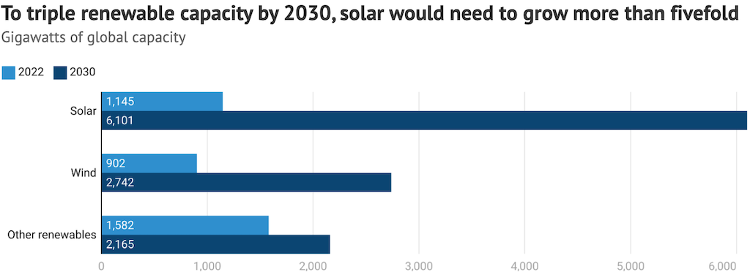
Credit: Carbon Brief
As the above chart shows, this would see solar capacity increasing by a factor of five from 2022 to 2030. Combined with a factor of three increase in wind, wind and solar would provide 92% of the tripled renewable capacity.
New hydroelectric, bioenergy, geothermal and other new technologies will account for the remaining 8% of new renewable capacity.
Who’s In?
It seems that this is a very popular proposal indeed. Reuters reports that more than 60 countries have said that they back a proposal led by the EU, the US and the UAE to triple renewable energy by 2030, double the rate of improving energy efficiency, and phase-down unabated coal power generation.
Reuters also reports that in a meeting earlier this month, the US and China jointly announced support for tripling global renewable energy capacity by 2030. However, it’s unclear whether China also supports the energy efficiency proposal, and any constraints on coal power generation will have to be very carefully worded to gain China’s support.
In fact, China appears to be ahead of the game. BloombergNEF reports that China will increase renewables capacity to about 3,900 GW by 2030, more than three times China’s capacity in 2022, and more than a third of the way to the COP 28 goal of 11,000 GW
However, support for renewable energy is a long way from buying into Dr. Al Jaber’s goal to “keep 1.5 alive.” Expect political fireworks at COP 28, whether or not there are oil deals happening under the table…

